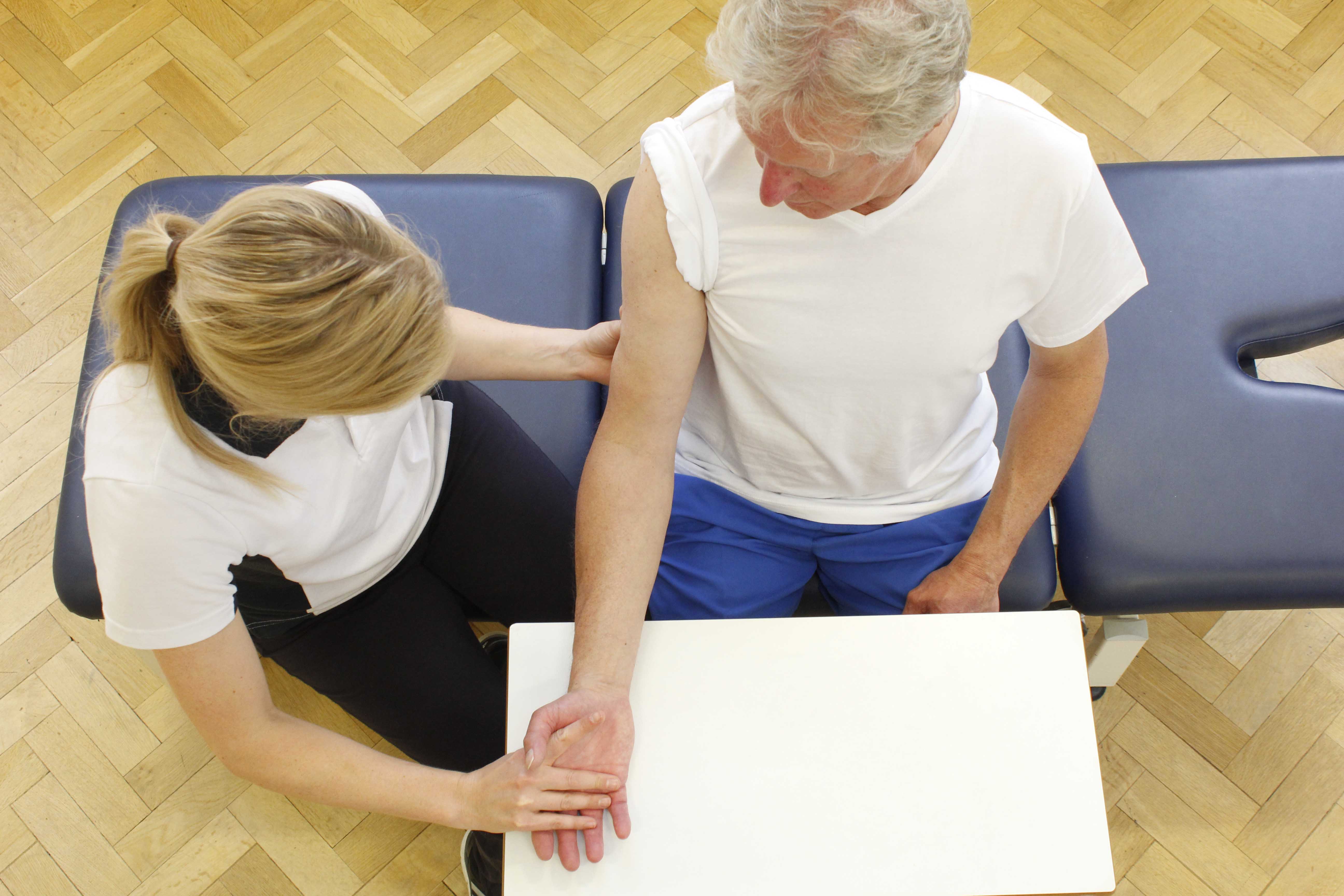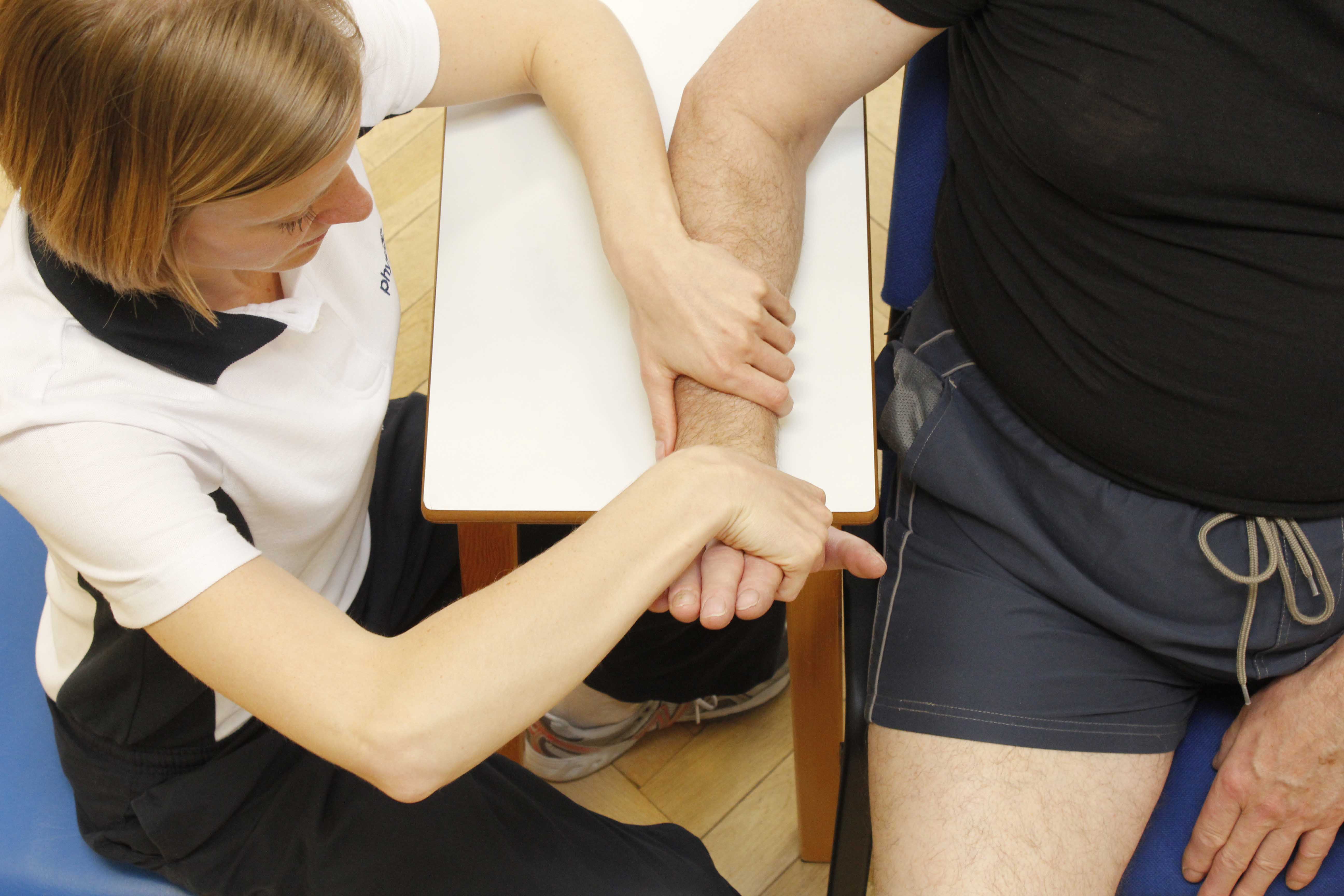Triangular Fibrocartilage Complex Surgery
Triangular fibrocartilage Complex Surgery is a procedure that repairs parts of the triangular fibrocartilage complex (TFCC) that has been damaged or injured. Physiotherapy after TFCC surgery is vital in order to return full function in the affected wrist, hand and arm.
The triangular fibrocartilage complex is a structure found between the bones of the forearm (radius and ulna) and the small wrist bones (carpal bones). The TFCC is triangular in shape and made up of several ligaments and cartilage including;
- The articular disc
- The meniscus homologue
- The ulnar collateral ligament
- The volar and dorsal radioulnar ligaments
- The sheath of the extensor carpi
 Above: Mobilisations of the wrist by experienced Physiotherapist
Above: Mobilisations of the wrist by experienced PhysiotherapistThe TFCC helps stabilise the wrist joint and acts as a focal point for force transmitted across the wrist to the ulnar side. The TFCC also makes it possible for the wrist to move in six different directions (bending, straightening, side to side and twisting both ways). Disruptions of the TFCC can occur from trauma or as the result of degeneration. Traumatic injury or a fall on an outstretched hand is the most common mechanism of injury where the hand is in a palm down position. Tearing or rupture of the TFCC occurs when there is enough force through the little finger (ulnar) side of the wrist and a large number of ruptures occur along with radius fractures.
One of the main symptom that appears as a result of a tear or rupture to the TFCC is pain along the ulnar side (little finger side) which is aggravated by activity involving wrist movements. Other symptoms include swelling, clicking, snapping, crepitus (crackling), weakness, instability, tenderness and a feeling of something catching inside the wrist joint.
Treatment of a TFCC injury depends on the severity of the damage and the structures involved. If the wrist is still stable then conservative treatment involving immobilisation followed by a comprehensive physiotherapy course is required. Instability as a result of complete or near to complete ligamentous tears requires surgery as soon as possible.
TFCC surgery takes place under general anaesthesia. The surgical procedure that is chosen and the incision made depend on the location of the TFCC lesion. Surgery may consist of the debridement (removal) of damaged tissue and tears of the articular disc or meniscal homologue that may be catching on other joint surfaces. TFCC surgery may also involve the repair of torn or ruptured structures. Damaged ligaments and tissues can be repaired by reattachment of the structures using sutures or other instrumentation such as wires or tacks to hold the repaired tissue in place until healing occurs. Surgery can be done arthroscopically (key hole) or by open surgery. Once the damaged TFCC has been repaired the wound is then closed using stitches or sutures.
Surgery to repair a damaged TFCC is required in order to reduce symptoms such as pain, instability and weakness that lead to reduced function in the forearm, wrist and hand. Physiotherapy after TFCC repair surgery is important to maximise the success of the surgery, prevent the likelihood of future problems occurring and help guarantee the return of full or near to full function in the wrist.
 Above: Stretches and mobilisations of the wrist and hand
Above: Stretches and mobilisations of the wrist and handSymptoms after TFCC repair surgery
After you have undergone TFCC repair surgery your wrist will be immobilised is a cast or bulky dressing. You will experience some pain which you will be given pain relief for. Your wrist will appear swollen and may be tender to touch therefore you will be advised to keep your wrist elevated above the level of your heart as much as possible. You can do this by using pillows during rest and you will be provided with a sling to wear when out and about for protection and support. Your temporary cast or dressing will be replaced with a fibreglass cast in a position where your palm is facing upwards (supination). Your elbow is able to move fully and this cast will be removed approximately six weeks after the operation. You will be advised to keep moving your elbow joint and fingers to maintain a good circulation and as much mobility as possible. Once your cast has been removed you can now participate in an intense physiotherapy course which will help you to regain strength, range of movement and function in you lower arm, wrist and hand as soon as possible after your surgery. You will be unable to drive until you have a full and painless range of movement in your wrist and hand.
Physiotherapy after TFCC repair surgery
It is important to undergo a comprehensive physiotherapy programme once you have received TFCC repair surgery. Physiotherapy after the surgery allows you to regain as much function as possible using various treatment methods and exercises. Your physiotherapy with Physio.co.uk will aim to reduce pain and stiffness as well as improve mobility, range of movement and strength in your affected lower arm, wrist and hand.Recovery after TFCC surgery may take 6-9 weeks. Physio.co.uk offers a programme that formulates goals which are personal to you. Goals may include:
- To restore a pain free wrist
- To restore full range of motion (ROM)
- To restore full muscle strength
- To restore full muscle length and flexibility
- To restore wrist stability
- Improve load bearing function of wrist
- To improve cardiovascular fitness and muscle endurance
- To re-establish function and independence
Week 1-4
In the initial few weeks after your surgery, your physiotherapy programme with Physio.co.uk will aim to reduce any pain and swelling you will be experiencing. Your wrist will be immobilised in a splint or cast for up to one month after your operation therefore physiotherapy will begin by focusing on pain control, maintaining range of movement in surrounding joints and minimising deconditioning of the wrist. Your physiotherapy at this stage will include:
- Pain killers (to control pain)
- Elevation (to control swelling)
- Passive (assisted) range of movement exercises for affected arm (wrist, hand, elbow and shoulder)
- Active (on your own)range of movement exercises for affected arm (wrist, hand, elbow and shoulder)
- Strengthening and range of movement exercises for unaffected arm
Week 4-6
Once your cast has been removed you can undergo a more intense course of physiotherapy with Physio.co.uk. The goals of your rehabilitation will include controlling pain and swelling, improving range of movement and flexibility along with increasing muscle strength. Additionally goals will be to improve muscle control in your wrist, hand and forearm. Your physiotherapy will include:
- Continuation of modalities for pain and swelling
- Passive (assisted) and active (independent) range of movement exercises
- Gentle strengthening exercises (isometric – hold) for muscles of affected arm (pronator teres, supinator, wrist flexor muscles, wrist extensor muscles, hand and finger muscles)
- Passive (assisted) stretching exercises for muscles of affected arm Range of movement, strengthening and stretching exercises for unaffected arm
- Mobilisation of wrist joints
- Hand grip strengthening exercises
- Wrist, hand and elbow exercises
- Hydrotherapy
Week 7-9
After 6 weeks of rehabilitation with Physio.co.uk, your physiotherapy programme will continue to focus on the progression from previous weeks. The main goals of your physiotherapy programme with Physio.co.uk will aim to minimise pain and improve function in your affected wrist. Rehabilitation will continue to include progressive strengthening exercises to reduce weakness, decrease instability, gain appropriate load bearing ability and improve muscle control. At this stage, your physiotherapy will also begin to include activities that will improve your cardiovascular fitness and muscle endurance. Your physiotherapy will include:
- Range of movement exercises for joints of hand, wrist and forearm
- Flexibility exercises
- Passive stretching (assisted) programme-with combined movement
- Strengthening exercises for muscles in affected and unaffected arm (pronator teres, supinator, wrist flexor muscles, wrist extensor muscles, hand and finger muscles)
- Mobilisation of wrist joints
- Hand grip strengthening exercises
- Load bearing exercises for wrist
- Hydrotherapy
- Arm cycle
Summary
Triangular fibrocartilage complex (TFCC) Surgery is a procedure that repairs parts of the triangular fibrocartilage complex that has been damaged or injured.The TFCC is triangular in shape and made up of several ligaments and cartilage and helps to stabilise the wrist joint. Damage to the TFCC can cause pain, swelling and instability within the wrist joint. Treatment of a TFCC injury depends on the severity of the damage and the structures involved. Instability as a result of complete or near to complete ligamentous tears requires surgery as soon as possible to repair the damaged structures. TFCC surgery may involve the debridement (removal) or damaged tissue and the repair of torn structures within the TFCC. Physiotherapy after TFCC surgery is crucial to maximise the success of the surgery, reduce pain and stiffness and improve mobility and function in the forearm, wrist and hand. A personal physiotherapy programme with Physio.co.uk will help you achieve the return of full or near to full function in your wrist and get you back to what it is you love doing the most as soon as possible.Call Physio.co.uk now on 0330 088 7800 for more information or to book an appointment please contact us.

 0330 088 7800
0330 088 7800

































